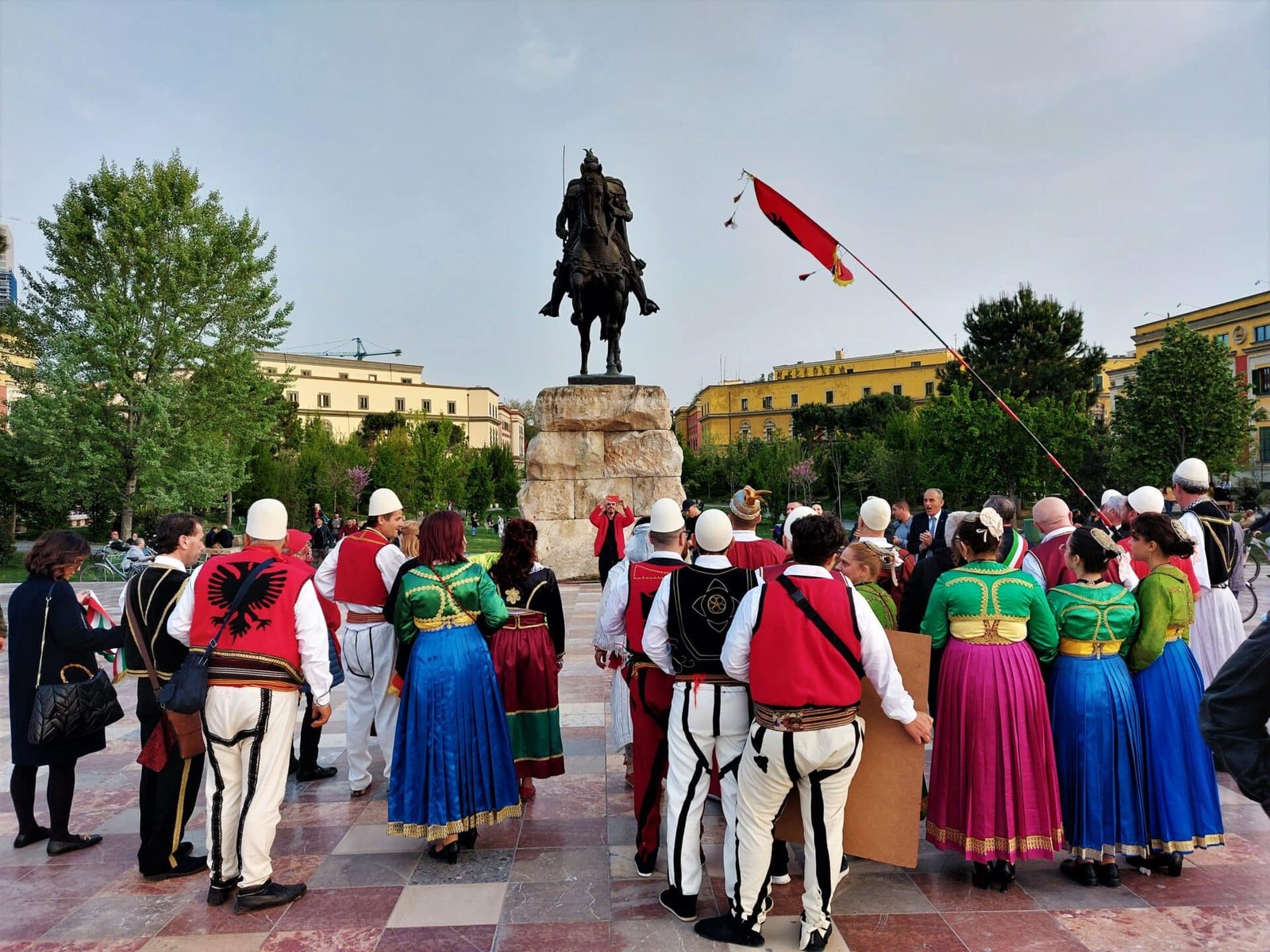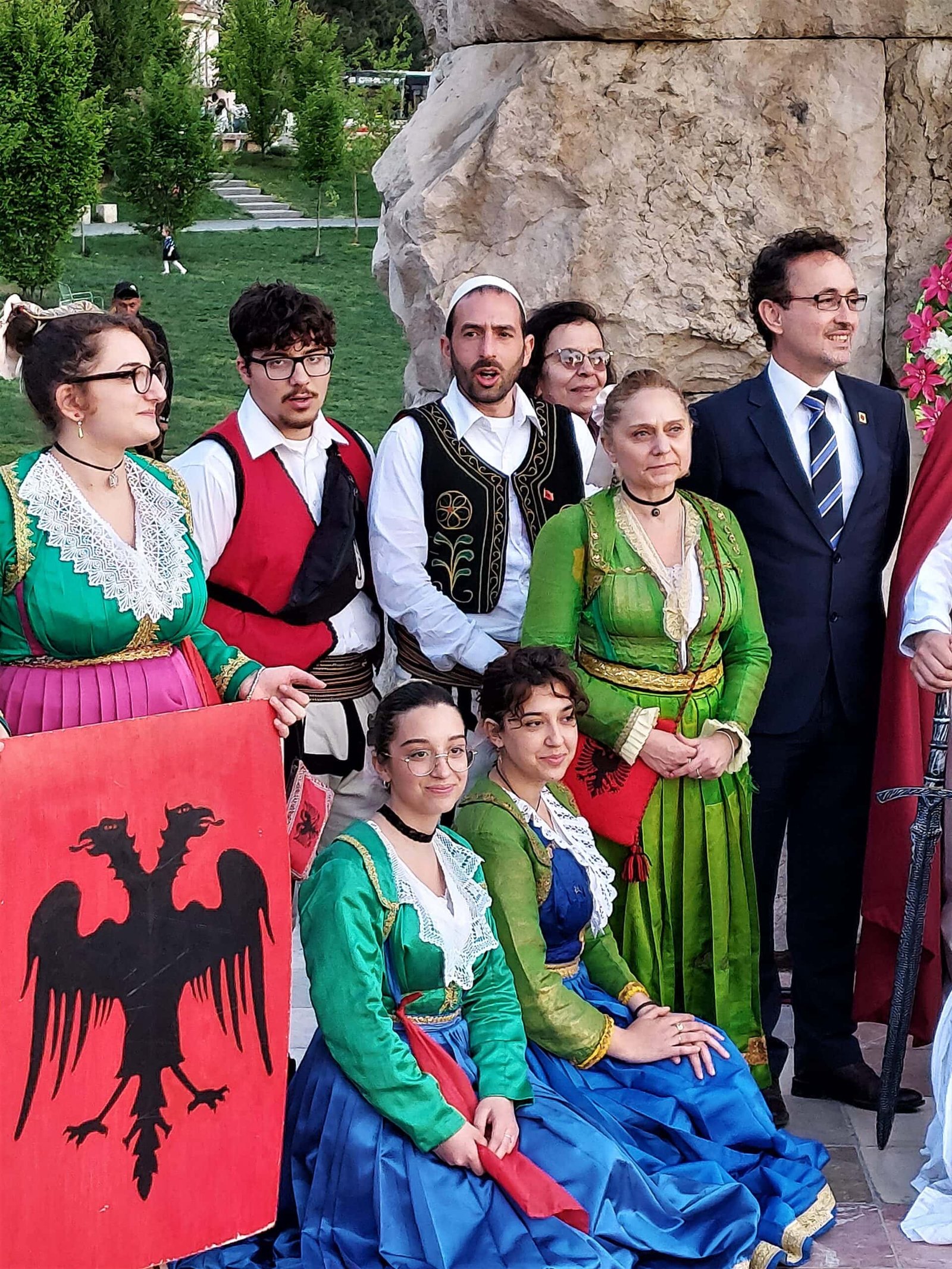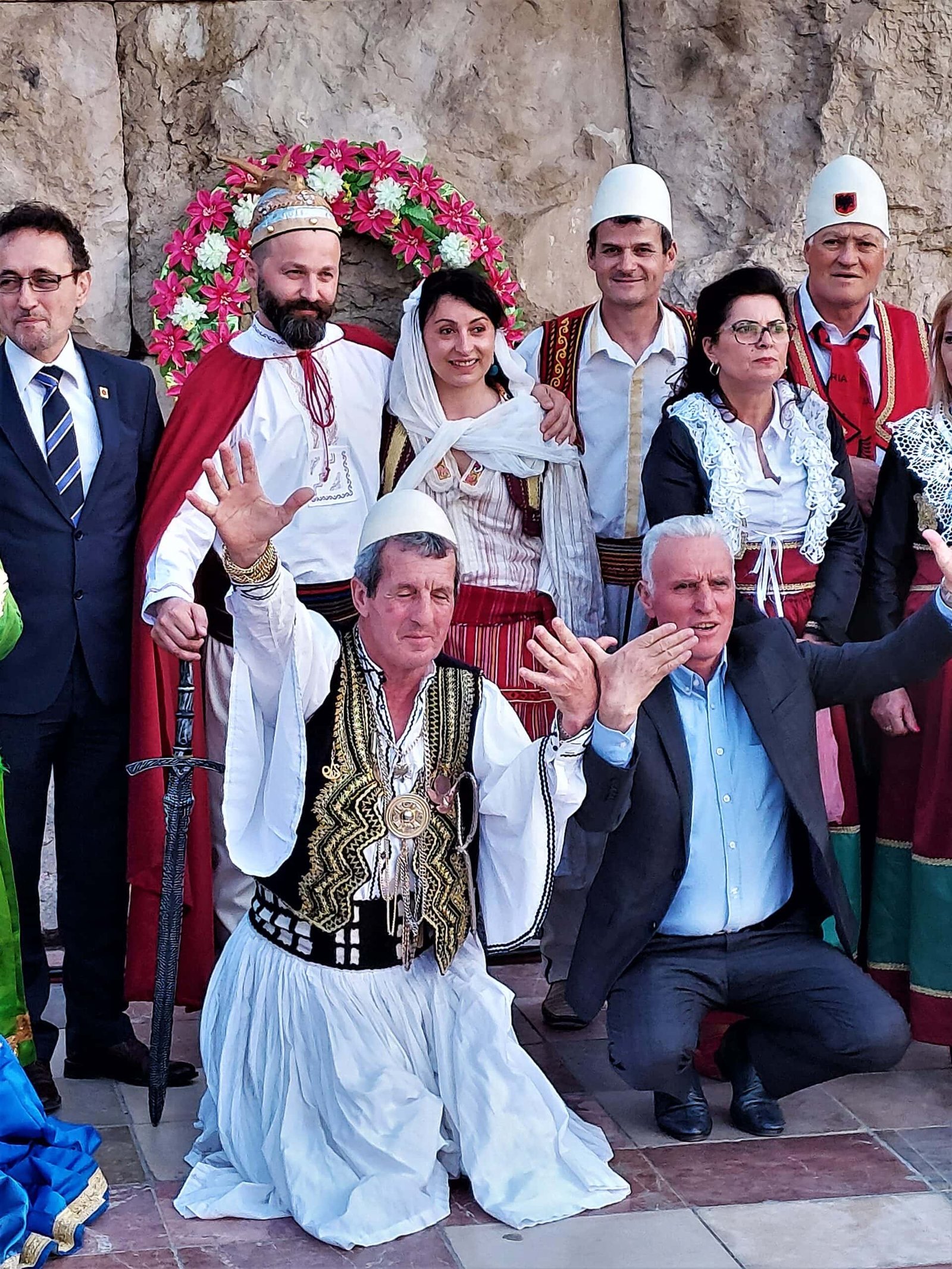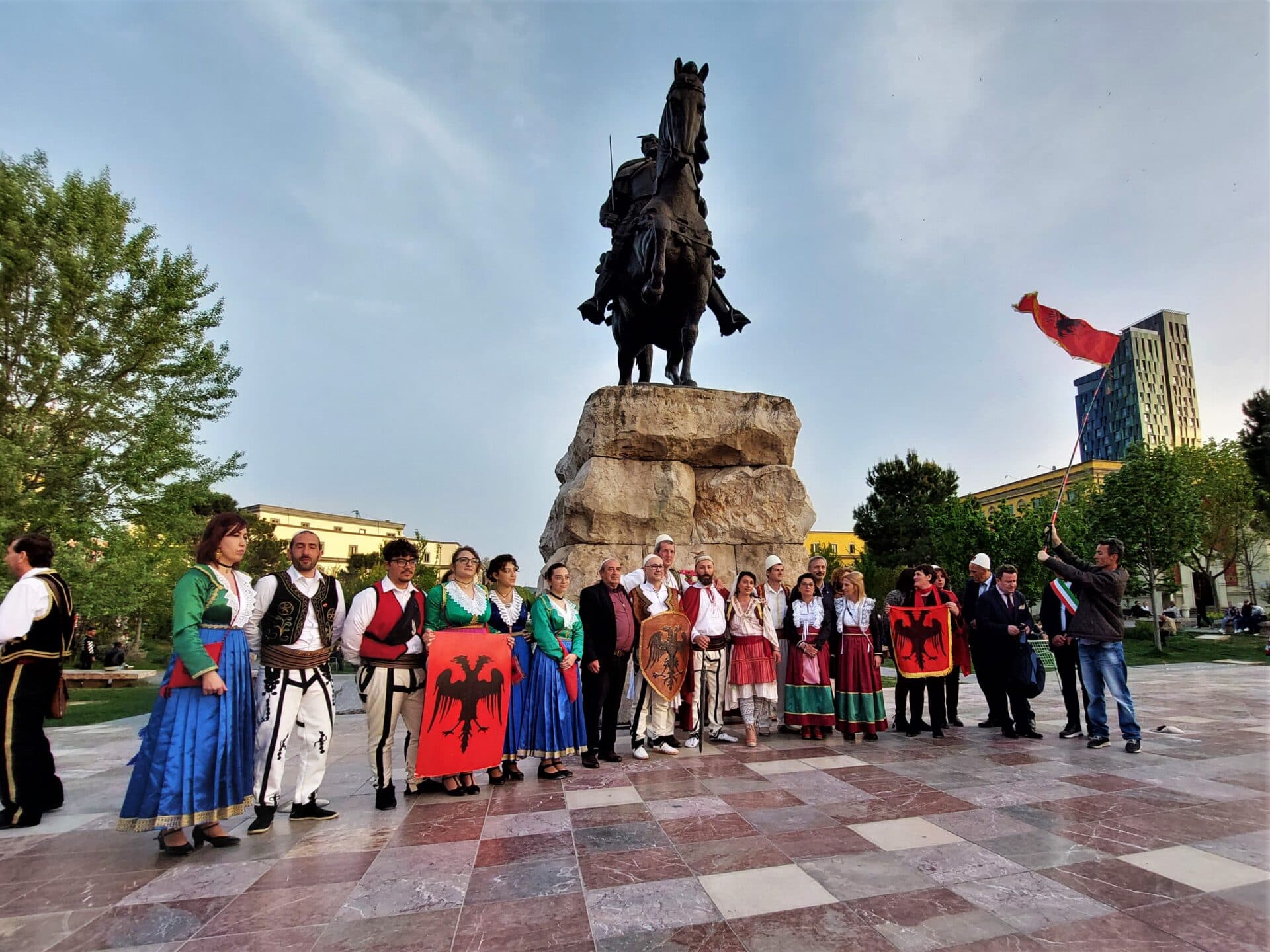“Anon from the castle walls
The crescent banner falls,
And the crowd beholds instead,
Like a portent in the sky,
Iskander’s banner fly,
The Black Eagle with double head;”
“And a shout ascends on high,
For men’s soul are tired of the Turks,
And their wicked ways and works,
That have made Ak-Hissar
A city of the plague;
And the loud, exultant cry
That echoes wide and far
Is: “Long live Scanderbeg!”
Scanderbeg: A poem, Henry Wadsworth Longfellow, 1873
The annals sing of a fierce man.
A man whose audacious actions shaped Albanian identity single-handedly. A man whose glorious deeds continue to echo through the passages of time.
Praiseful, they sing of the great Skanderbeg, legendary “Lord of Albania”.
At a time when Europe’s monarchs trembled in fear over a ferociously expanding Ottoman realm running rampant across the Balkans, few forsaw the continent’s salvation to hail from the wild mountains of Albania.
However, determined to rid his ancestral homeland from the Turkish scourge, Skanderbeg, abducted at a young age and educated at the Ottoman court, forsook the Sultan, united the otherwise warring Albanian aristocracy under his banner, and drew his sword against a seemingly unstopable foe.
Yet as the smoke cleared, carried by the joyeous cheers of his jubilant men, a black, double-headed eagle proudly soared above the slain.
Against all odds, Skanderbeg had emerged victorious.
THE ORIGINS OF THE ALBANIAN FLAG
Following her independence from the Ottoman Empire in 1912, Albania revealed a new national flag to the world: a black, double-headed eagle on red ground, representing valour, courage, strength, and bloodshed (red ground), and a sovereign Albanian nation (double-headed eagle).
Modelled after the Kastrioti family's coat of arms (Skanderbeg's Christian name is Gjergj Kastrioti), the flag pays tribute to the League of Lezhë (the first united Albanian political entity during the Middle Ages), as well as the general's valiant fight for freedom. Interestingly, ever since its inception, the flag has only seen minor changes no matter who ruled the country. Not even the communists had the audacity to alter Skanderbeg's legacy and simply added a golden star after their ascent to power.
Triumph followed triumph, and soon tales of his stalwart defiance spread through European courts like wildfire. The desperately awaited news also reached the halls of the Holy See, and before long the pope crowned Skanderbeg athleta christi (“Champion of Christ”) deeming his fight no less than the vindication of Christendom in its entirety.
Nevertheless, absent support by the continent’s nobility, who were quick to praise but reluctant to open their coffers, ultimately rendered his courageous efforts a losing battle.
In 1468, Skanderbeg finally succumbed to a disease while reorganising his host. Upon learning of his adversary’s unexpected passing, Sultan Mehmed II is said to have proclaimed: “The Christan land, has lost its sword and shield.”
Albania now exposed, Skanderbeg’s kin, dreading the Sultan’s wrath, took to the seas and fled into exil across the Adriatic.
Even though, Skanderbeg never witnessed his beloved homeland freed from the yoke of occupation, his legendary battle for liberty elevated him to very top of Albanian identity. To this day, he is revered as the country’s national hero and considered by many to be the greatest general Albania has ever seen.
This holds especially true for a very peculiar Albanian minority settled in the south of Italy.

During my time in Tirana, Albania’s laid-back capital, I came across an intriguing sight.
On a mild spring evening, I was strolling across the colourful marble tiles of Skanderbeg Square filled with the murmur and chatter of a bustling city, when my path was suddenly interrupted. Occupying the pavement in front of me, stood a festive group clad in a plethora of extravagant costumes.
While the men boasted a relative subtle colour palette of red jackets and white trousers, their most prominent feature being the white Albanian qeleshe (a distinct headwear), in stark contrast the women paraded a flamboyant mix of colourful, silken gowns embellished with delicate golden embroidery and white lace around the décolleté.
However, amidst this most unusual procession two things in particular caught my attention: the striking number of double-headed eagles displayed on satchels, shilds, and vests, as well as a well-groomed man wielding a sophisticated sword while wearing a particularly inimitable helmet, which I had, not too long ago, seen grace the head of the great Skanderbeg.


While I stood there wondering, trying to understand this strange ensemble, an older woman approached me with an absolutely mesmerising story. These people, she spouted proudly, claimed ancestry from the country’s most fabled hero, Skanderbeg, himself!
They were the direct descendents of his exiled kinsfolk that sought refuge in Italy more than 550 years ago, and had come to duly pay their respects and celebrate the everlasting legacy of their famous forefather and the continuation of his lineage. Annual festivities had existed since medieval times, however, since the fall of the communist regime in the 90s and the consequent opening of the once barred off nation, pilgrimages to Albania had become the norm, as well.
As I tried to process this astonishing revelation, the group began to move swiftly towards the centre of the square, chanting, rejoicing, vigorously hailing their fallen father.
And there he stood stoically, exalted on a rearing steed, his eyes fixated on the horizon, his hands on the reins: Gjergj Kastrioti, commonly known as Skanderbeg, immortalised in bronze. Beneath his watchful eyes, the group positioned itself in front of the statue for the final act of the celebaration, and, as it had done hundreds of years prior, elevated by the sounds of jubilation, the double-headed eagle soared lofty.
By sheer luck I was experiencing something extraordinary. An unusual show of permanence: the collective memory of an entire group passed down through the generations displayed for the world to witness.
However, after a few minutes, this fascinating spectacle ceased as quickly as it had started. And thus, as the crowd slowly dispersed, Skanderbeg’s heirs once more departed for their exile across the Adriatic Sea.
Yet this time willingly.
